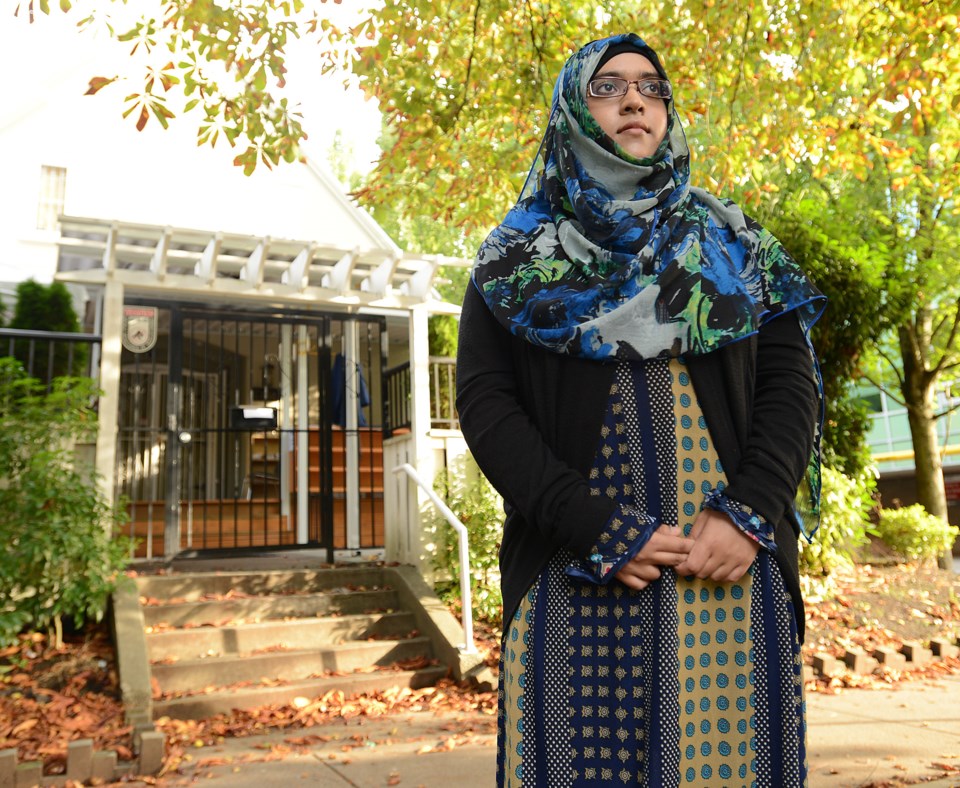Today, as many as two million Muslims from around the world will converge on Mount Arafat, near Mecca, Saudi Arabia, and, in one of the largest gatherings of people in the world, “stand before God” in supplication.
The day at Arafat is the culmination of the annual Hajj, the pilgrimage that is one of five pillars of Islam and an obligation for every Muslim with the physical and financial capability of performing it.
Tasnim Anwar, an East Vancouver woman who recently graduated from UBC with a degree in biochemistry, performed the Hajj last year.
“Most people accumulate their savings and opt to perform the Hajj later in life,” she says. “But I was actually very lucky because my parents were performing Hajj and they asked if I wanted to do it with them.”
The family of three arranged the pilgrimage through a Richmond travel agent. Their contingent was joined by others from Ottawa and Alberta, including Somali-Canadians and a Pakistani-Canadian family who, along with Anwar’s Bengali-speaking family — her parents immigrated to Canada from Bangladesh — resulted in a very multilingual busload.
Anwar’s group first visited Medina which, while not officially part of the Hajj, is the birthplace of the Prophet Muhammad and the place from which the first Hajj originated, in the year 630. While the Hajj is closely associated with Muhammad, the rituals associated with it are often traced to the biblical figure known to Muslims as Ibrahim (and as Abraham to Jews and Christians).
Between Medina and the holy city of Mecca, their bus stopped to allow pilgrims to don the appropriate attire for the Hajj. Women may wear whatever is usually appropriate for Muslim women, though they must not cover their faces or hands, while men are required to wear an ihram, a word that refers both to the sacred spiritual state a Muslim must enter before beginning the Hajj and to the garment he wears, which is two unstitched pieces of white cloth.
Pilgrims follow a proscribed five-day procession that includes circling seven times the Ka’aba, the holiest structure in Islam’s holiest mosque, the place to which all Muslims face during prayer. They also cast stones at pillars representing the devil and repeat numerous symbolic acts now nearly 1,400 years old, all while performing the five-times-a-day prayers and with miles of walking between holy sites.
One of the rites of the Hajj — walking seven times between the hills of Al-Safa and Al-Marwah — reflects the teaching that Ibrahim’s wife Hagar raced seven times between these places looking for food and water for her infant son Ishmael. The narrative says that when Hagar finally appealed to Allah, Ishmael’s heel touched the ground and the spring of water called the Zamzam Well miraculously sprang forth. Now incorporated into the Hajj, this procession of seven journeys includes drinking from the Zamzam Well.
The festival of Eid al Adha, which takes place during Hajj, commemorates Ibrahim’s willingness to sacrifice his son as a sign of his submission to Allah, who is said to have provided a lamb as a substitute. The festival is marked with the sacrifice of animals and while, in years past, pilgrims themselves performed or oversaw the sacrifices, most now purchase a voucher that authorizes another to perform the sacrifice in their stead. The resulting meat is distributed to the poor in some 30 countries and, according to Saudi government sources, more than 600,000 animals are slaughtered in modern facilities constructed in recent decades for the purpose.
For Anwar, one of the most challenging parts of the Hajj was the night spent sleeping under the open sky in the Arabian desert.
“That was really tough, if I’m perfectly honest,” she says. “There’s no hotel, there is no tent, you just sleep in the middle of the plain essentially. It’s very humbling. It doesn’t matter whether you come from a rich background or a poor background, all Muslims have to sleep on the ground there.”
The Kingdom of Saudi Arabia in recent decades has invested a reported $100 billion in infrastructure for pilgrims. There are now air conditioned tents, sprinklers blasting a fine mist over acres of ground, and easily available refrigerated water and other necessities. Still, the experience is not easy, and neither, Anwar says, should it be.
“Hajj is not meant to be something easy, like a vacation,” she says. “It’s meant to be a real struggle. It’s a real practical test of your patience, of your self-endurance.”
Indeed, until recent decades, those leaving for the Hajj would ensure their earthly affairs were in order because some would not return from the gruelling pilgrimage. Scores still die of old age and natural causes each year — and stampedes some years result in more deaths. Health officials are particularly concerned about the potential spread of Ebola during this year’s Hajj.
For Anwar, the experience reinforced her core spiritual outlook.
“One of the goals of Hajj is to develop a universalistic character, where you view everyone as part and parcel of God’s creation,” she says. “A lot of time when we’re listening to the news we see clashes between Muslims. But Hajj is a time to realize that everyone is God’s creation.”



